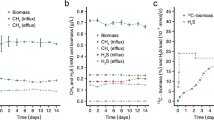Abstract
Methanosarcina barkeri and Desulfobacter postgatei are ubiquitous anaerobic bacteria which grow on acetate or acetate plus sulfate, respectively, as sole energy sources. Their apparent K s values for acetate were determined and found to be approximately 0.2 mM for the sulfate-reducing bacterium and 3 mM for the methanogenic bacterium. In mixed cell suspensions of the two bacteria (adjusted to equal V max) the rate of acetate consumption by D. postgatei approached 15-fold the rate of M. barkeri at low acetate concentrations. The apparent inhibition of methanogenesis was of the same order as expected from the different K s value for acetate. Difference in substrate affinities can thus account for the inhibition of methanogenesis from acetate in sulfate-rich environments, where the acetate concentration is well below 1 mM.
Similar content being viewed by others
References
Badziong W, Thauer RK (1978) Growth yields and growth rates of Desulfovibrio vulgaris (Marburg) growing on hydrogen plus sulfate and hydrogen plus thiosulfate as the sole energy sources. Arch Microbiol 117:209–214
Bode C, Goebell H, Stähler E (1968) Zur Eliminierung von Trübungsfehlern bei der Proteinbestimmung mit der Buiretmethode. Z klin Chem u klin Biochem 6:418–422
Fenchel T, Blackburn TH (1979) Bacteria and mineral cycling. Academic Press, London New York San Francisco
Fersht A (1977) Enzyme structure and mechanism. Freemann and Co, Reading San Francisco
Hippe H, Caspari D, Fiebig K, Gottschalk G (1979) Utilization of trimethylamine and other N-methyl compounds for growth and methane formation by Methanosarcina barkeri. Proc Natl Acad Sci USA 76:494–498
Jørgensen BB (1980) Mineralization and the bacterial cycling of carbon, nitrogen and sulfur in marine sediments. In: Ellwood DC, Hedger JN, Latham MJ, Lynch JM, Slater JH (eds) Contemporary microbial ecology. Academic Press, London New York Toronto Sydney San Francisco, pp 239–251
Kaspar HF, Wuhrmann K (1978) Kinetic parameters and relative turnovers of some important catabolic reactions in digesting sludge. Appl Environ Microbiol 36:1–7
Kristjansson JK, Schönheit P, Thauer RK (1982) Different K s values for hydrogen of methanogenic bacteria and sulfate reducing bacteria: An explanation for the apparent inhibition of methanogenesis by sulfate. Arch Microbiol 131:278–282
Laanbroek HJ, Pfennig N (1981) Oxidation of short-chain fatty acids by sulfate-reducing bacteria in freshwater and in marine sediments. Arch Microbiol 128:330–335
Mah RA, Smith MR, Baresi L (1978) Studies on an acetate-fermenting strain of Methanosarcina. Appl Environ Microbiol 35:1174–1184
Mah R, Smith MR, Ferguson T, Zinder S (1981) Methanogenesis from H2-CO2, methanol, and acetate by Methanosarcina. In: Dalton H (ed) Microbial growth on C1 compounds, Heyden, London Philadelphia Rheine, pp 131–145
Mah RA, Ward DM, Baresi L, Glass TL (1979) Biogenesis of methane Ann Rev Microbiol 31:309–342
Matin A, Veldkamp H (1978) Physiological basis of the selective advantage of a Spirillum sp. in a carbon-limited environment. J Gen Microbiol 105:187–197
McCarty PL (1972) Energetics of organic matter degradation. In: Mitchell R (ed) Water pollution microbiology. Wiley-Interscience, New York, pp 91–113
Mountfort DO, Asher RA (1981) Role of sulfate reduction versus methanogenesis in terminal carbon flow in polluted intertidal sediment of Maimea inlet, Nelson, New Zeland. Appl Environ Microbiol 42:252–258
Mountfort DO, Asher RA, Mays EL, Tiedje JM (1980) Carbon and electron flow in mud and sandflat intertidal sediments of Delaware inlet, Nelson, New Zealand. Appl Environ Microbiol 39:686–964
Oremland RS, Taylor BF (1978) Sulfate reduction and methanogenesis in marine sediments. Geochim Cosmochim Acta 42:209–214
Sansone FJ, Martens CS (1981) Methane production from acetate and associated methane fluxed from anoxic coastal sediments. Science 211:707–709
Scherer P, Sahm H (1981) Influence of sulphur-containing compounds on the growth of Methanosarcina barkeri in a defined medium. Eur J Appl Microbiol Biotechnol 12:28–35
Schönheit P, Moll J, Thauer RK (1980) Growth parameters (K s, μmax, Y s) of Methanobacterium thermoautotrophicum. Arch Microbiol 127:59–65
Smith PH, Mah RA (1966) Kinetics of acetate metabolism during sludge digestion. Appl Microbiol 14:368–371
Smith RS, Mah RA (1978) Growth and methanogenesis by Methanosarcina strain 227 on acetate and methanol. Appl Environ Microbiol 36:870–879
Sørensen J, Christensen D, Jørgensen BB (1981) Volatile fatty acids and hydrogen as substrates for sulfate-reducing bacteria in anaerobic marine sediments. Appl Environ Microbiol 42:5–11
Thauer RK (1982) Dissimilatory sulfate reduction with acetate as electron donor. In: Philosophical Transactions of the Royal Society London, in press
Thauer RK, Jungermann K, Decker K (1977) Energy conservation in chemotrophic anaerobic bacteria. Bacteriol Rev 41:100–180
Veldkamp H, Jannasch HW (1972) Mixed culture studies with the chemostat. J Appl Chem Biotechnol 22:105–123
Widdel F, Pfennig N (1977) A new anaerobic, sporing, acetate-oxidizing, sulfate-reducing bacterium, Desulfotomaculum (emend.) acetoxidans. Arch Microbiol 122:119–122
Widdel F, Pfennig N (1981a) Studies on dissimilatory sulfate-reducing bacteria that decompose fatty acids. I. Isolation of new sulfate-reducing bacteria enriched with acetate from saline environments. Description of Desulfobacter postgatei gen. nov., sp. nov. Arch Microbiol 129:395–400
Widdel F, Pfennig N (1918b) Sporulation and further nutritional characteristics of Desulfotomaculum acetoxidans. Arch Microbiol 129:401–402
Winfrey MR, Zeikus JG (1977) Effect of sulfate on carbon and electron flow during microbial methanogenesis in freshwater sediments. Appl Environ Microbiol 33:275–281
Winter J, Wolfe RS (1979) Complete degradation of carbohydrate to carbon dioxide and methane by synthrophic cultures of Acetobacterium woodii and Methanosarcina barkeri. Arch Microbiol 121:97–102
Zehnder AJB, Brock TD (1979) Biological energy production in the apparent absence of electron transport and substrate level phosphorylation. FEBS Lett 107:1–3
Zehnder AJB, Huser BA, Brock TD, Wuhrmann K (1980) Characterization of an acetate-decarboxylating, non-hydrogen-oxidizing methane bacterium. Arch Microbiol 124:1–11
Zehnder AJB, Ingvorsen K, Marti T (1982) Microbiology of methane bacteria. In: Hughes DE, et al. (eds) Anaerobic digestion 1981. Elsevier Biomedical Press, Amsterdam New York Oxford, pp 45–68
Zinder SH, Mah RA (1979) Isolation and characterization of a thermophilic strain of Methanosarcina unable to use H2−CO2 for methanogenesis. Appl Environ Microbiol 38:996–1008
Author information
Authors and Affiliations
Rights and permissions
About this article
Cite this article
Schönheit, P., Kristjansson, J.K. & Thauer, R.K. Kinetic mechanism for the ability of sulfate reducers to out-compete methanogens for acetate. Arch. Microbiol. 132, 285–288 (1982). https://doi.org/10.1007/BF00407967
Received:
Accepted:
Issue Date:
DOI: https://doi.org/10.1007/BF00407967




